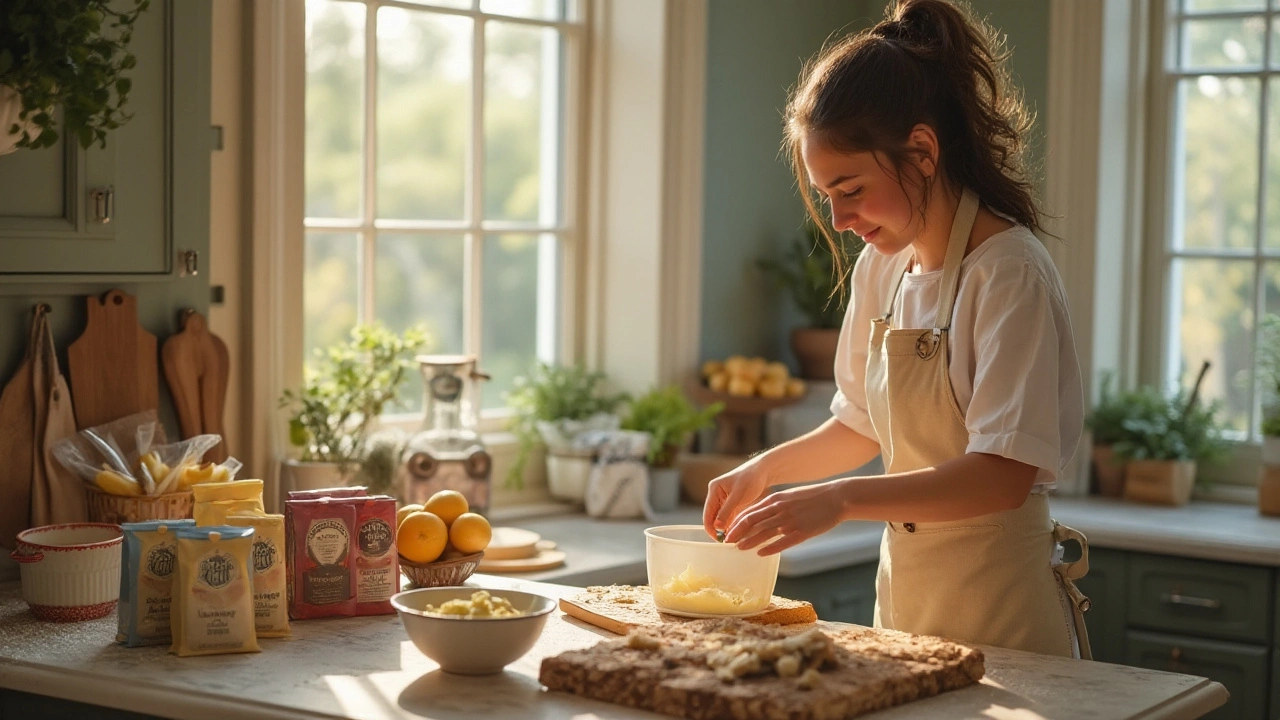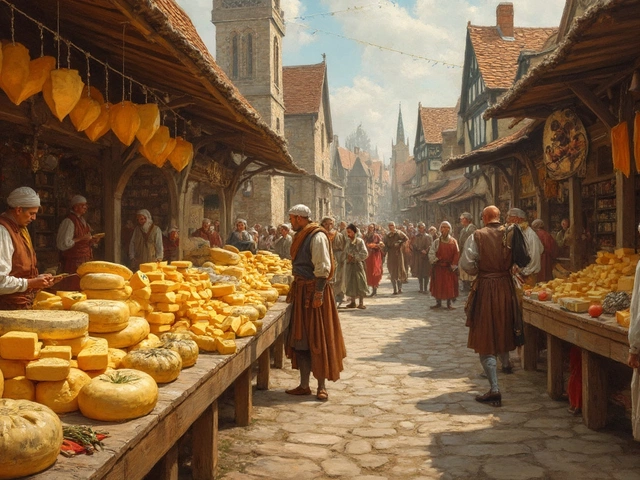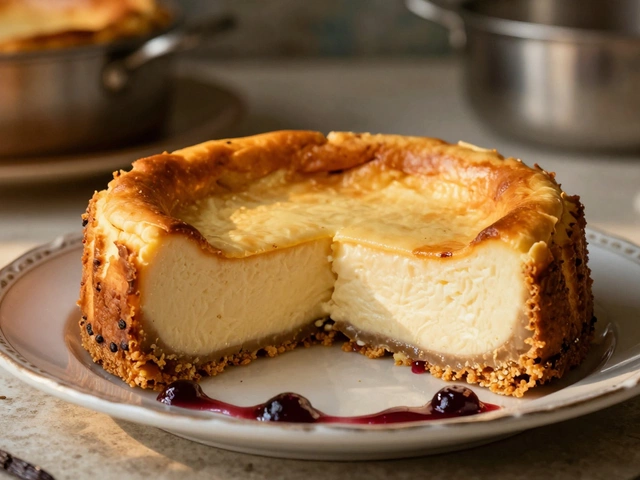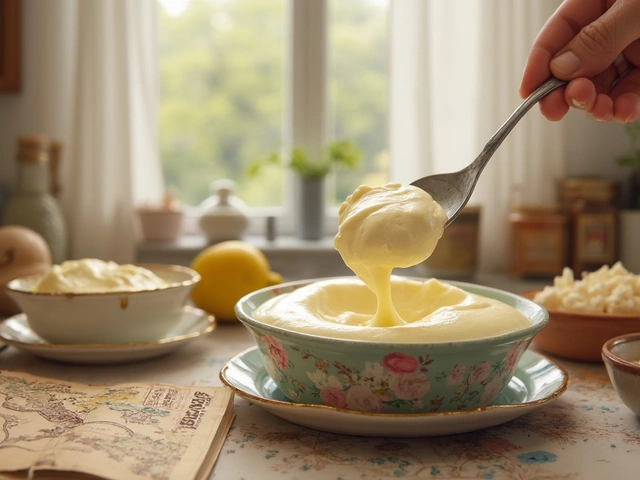When it comes to the topic of gluten and its absence in our diets, people often find themselves left with more questions than answers. Among the many food items caught in the swirl of curiosity are potatoes. These earthy delights, humble yet versatile, often beckon the question: are they truly gluten-free? And more intriguingly, can they play a role in crafting delectable gluten-free cakes?
Join us as we explore not just the basics, but also the potential of potatoes in creating celiac-friendly cakes that are as scrumptious as they are safe to consume. From understanding what makes potatoes inherently free of gluten to discovering the transformative role of potato flour in baking, this article is here to guide and inspire. Whether you're a dedicated gluten-free baker or just starting your journey, prepare to uncover new culinary possibilities with potatoes.
- Understanding Gluten and Gluten-Free Diets
- Are Potatoes Naturally Gluten-Free?
- Potatoes in Gluten-Free Baking
- Potato Flour: A Gluten-Free Baking Essential
- Recipe Ideas for Potato-Based Gluten-Free Cakes
- Tips for Cooking and Baking with Potatoes
Understanding Gluten and Gluten-Free Diets
Gluten, a family of proteins found in grains such as wheat, barley, and rye, has often been vilified in contemporary dietary conversations. Thanks to its sticky nature, gluten provides elasticity to dough, helping it rise and maintain its shape. However, for individuals with celiac disease or gluten sensitivity, consuming gluten can lead to a host of uncomfortable symptoms, ranging from digestive issues to more severe health complications. As awareness grows, many people choose to follow a gluten-free diet, not only to cater to these conditions but also as a lifestyle choice, promoting better digestion and well-being.
The journey into gluten-free living begins with understanding what gluten is and how it interacts with our bodies. Owing to its ability to mimic various textures, gluten finds its way into countless food products, not just typical bread and pasta. This means that those opting to avoid it must be vigilant in reading labels and familiarizing themselves with gluten's many names and forms. The process might seem daunting, but it is essential for avoiding the accidental consumption of the protein. Gluten's presence extends beyond foods into items like medications and beauty products, albeit in lesser known instances. A comprehensive approach to gluten-free living involves not only dietary changes but also a knowledge of cross-contamination risks in shared cooking spaces.
For perspective, Dr. Alessio Fasano, an expert in the field of celiac research, once stated,
"Celiac disease is the most common genetically and nutritionally triggered food intolerance known today, affecting about 1% of the world's population."This highlights the crucial need for ongoing education and support for those managing the condition. It's fascinating that awareness and options for gluten-free products have skyrocketed in recent years, transforming from niche market needs to mainstream availability. As this trend continues, so does the refinement of gluten-free cooking techniques, making it easier to replicate textures and tastes that were once thought to be exclusive to gluten-containing foods.
For those just starting out on a gluten-free diet, it's vital to know which foods are inherently safe. This is where potatoes enter the conversation. Naturally devoid of gluten, these tubers offer both versatility and nutrition. From humble mashed potatoes to intricate potato breads and cakes, they serve as a staple ingredient for many seeking to replace gluten-heavy components. The goal of a gluten-free diet, whether medically required or personally chosen, lies in achieving balance and satisfaction in food, ensuring that nourishment goes hand-in-hand with enjoyment. As our understanding grows, so too does the potential to craft a diverse and delightful gluten-free diet without compromising on flavor or indulgence.
Are Potatoes Naturally Gluten-Free?
When diving into the myriad world of dietary restrictions, one question often comes to the forefront: are potatoes a suitable option for those on a gluten-free diet? The simple, reassuring answer is yes, potatoes are indeed naturally gluten-free. These tubers belong to a completely different food group than grains like wheat, barley, or rye, which are notorious for containing gluten. As vegetables, potatoes are inherently free of this protein that many seek to avoid. This makes them a popular staple for those adhering to gluten-free living. However, it’s important to be cautious about how potatoes are prepared and processed, as this can affect their gluten-free status.
Now, let's unravel the journey of potatoes from farm to table. The potato, in its natural state, is devoid of gluten. Problematic gluten sneaks in when these tubers are processed or prepared in environments where gluten is present. Cross-contamination is a real concern, especially in industrial settings. For instance, if potatoes are fried in oil that has been used for breaded foods, or if they are coated with a batter containing flour, their status can swiftly change. Thus, while the potato itself remains naturally gluten-free, the manner in which it arrives at your plate can to some extent determine its suitability for a gluten-free diet.
Considering its naturally gluten-free credential, the potato shines like a beacon of culinary possibilities. It is worth noting that they are not just safe but incredibly nutritious. Potatoes are packed with essential nutrients such as vitamin C, vitamin B6, potassium, and dietary fiber, making them a fantastic choice for not only gluten-free diets but also for any health-conscious meal plans. The nutrient-rich skin is often recommended to be eaten as well, offering an additional health boost. An interesting nugget of knowledge comes from Jeffrey Blumberg, a well-respected professor of nutrition science who once noted,
"Potatoes are an exceptionally good source of potassium, even containing more of this mineral than a banana."
While glancing beyond the mundane mashed potato, these tubers manifest culinary versatility. For those in search of innovative ways to maintain a gluten-free lifestyle, consider the expansive use of potatoes in all their glorious forms. From as simple as boiled or baked dishes to culinary marvels like potato-based gnocchi, their adaptability is unmatched. Let us not omit to discuss their pivotal role in gluten-free baking. With potato flour, a derivative from finely ground starch-rich potatoes, being a popular choice for those avoiding gluten. Delicious cakes and pastries owe their moistness and fluffiness to this secret ingredient, empowering gluten-free bakers to craft textures that were once deemed implausible in the absence of gluten.
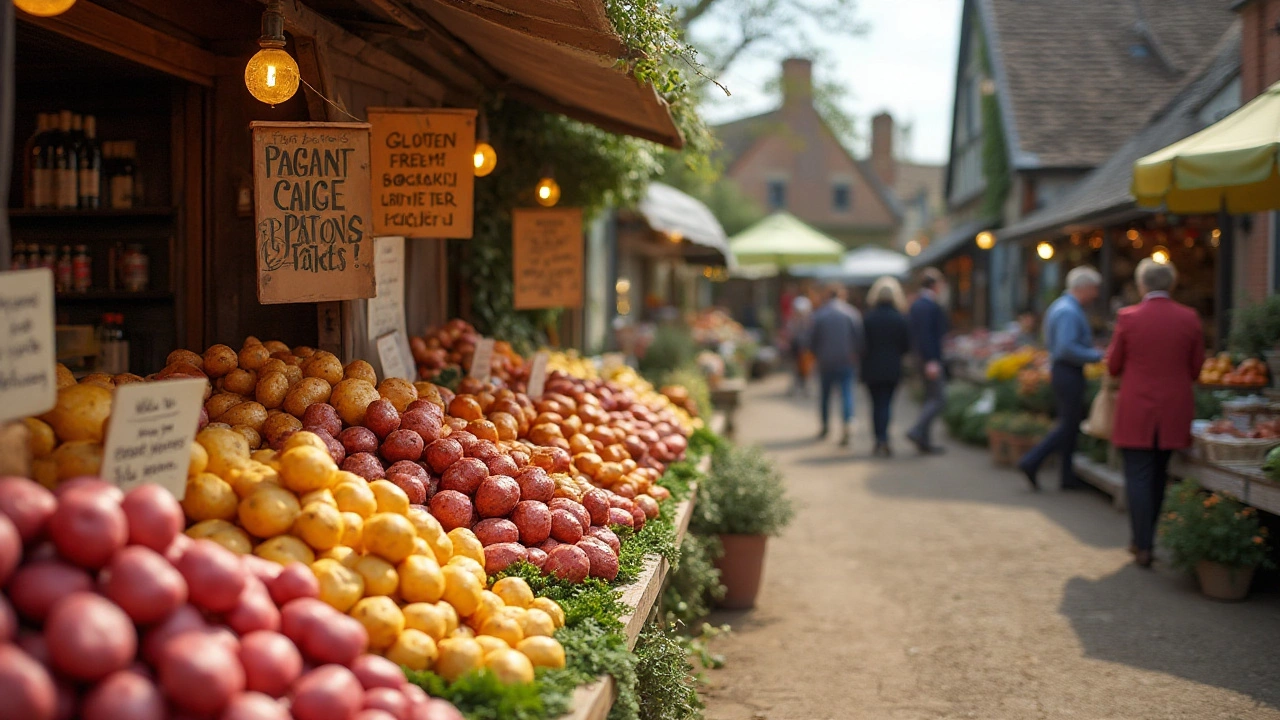
Potatoes in Gluten-Free Baking
When it comes to baking without gluten, the role of potatoes is often misunderstood or underestimated. These starchy life-savers aren't merely a side dish; they pack a punch in the realm of gluten-free alternatives. Potatoes, whether cooked and mashed or transformed into a fine flour, are incredibly versatile ingredients in the kitchen. Their natural starch content provides a coveted moisture and binding ability, which is especially beneficial for those who have ventured into the sometimes challenging world of gluten-free baking. Due to these properties, mashed potatoes can add a rich, velvety texture to gluten-free cakes, keeping them moist without making them dense—a common pitfall in many flourless recipes.
The innovation doesn't just stop at mashed potatoes. Potato flour, derived from whole potatoes, has had its quiet revolution in the pantry of many gluten-free bakers. This flour not only contributes a mild flavor that accommodates both sweet and savory dishes but also enhances the structure and shelf life of baked goods. Its ability to hold moisture superbly means that your cakes stay fresh and delightful longer, a challenge often faced by those baking gluten-free. It’s suitable for a myriad of cakes, from the basic vanilla sponge to elaborate layer cakes laden with cream and fruit.
When using potatoes or potato derivatives in your gluten-free cakes, it's important to understand their characteristics. While potato flour is not the same as potato starch, the latter also brings its own benefits by acting as a great thickening agent and helping to create light and fluffy textures. The key difference lies in flavor and strength—potato starch is almost tasteless and can be overpowering if not measured correctly. A balance often favored by seasoned bakers includes mixing potato flour with other gluten-free flours like almond or rice to achieve the perfect blend of texture and taste.
As we explore further, it's fascinating to note how ancient cultures have revered potatoes, not just as a staple food but as a transforming ingredient in their sweets and treats. There’s something historically rich about using ingredients like potatoes, underscoring their timelessness. This is best captured in the words of famous chef Julia Child, who once said,
"With enough butter, anything is good."Though she wasn't specifically referencing potatoes, the sentiment holds—potatoes have the potential to enhance gluten-free cuisine exponentially with the right ingredients.
For those of you delving into gluten-free baking, it might be illuminating to try your hand at incorporating potatoes in new and innovative ways. Imagine a world of possibilities where the humble spud transforms the way you bake, ensuring that you never have to compromise on flavor or texture. With potentials like these, potatoes are truly a baker's secret weapon in crafting perfect gluten-free delights.
Potato Flour: A Gluten-Free Baking Essential
When diving into the world of gluten-free baking, you'll inevitably stumble upon potato flour—an unsung hero in creating delectable pastries and breads for those with gluten sensitivities. Derived from whole potatoes that are cooked, dried, and finely ground, potato flour brings a unique set of qualities to the table, especially for those committed to a celiac-friendly lifestyle. Its naturally gluten-free nature is not just a relief to those wary of gluten; it is also a boon to bakers for its uncanny ability to retain moisture and impart a tender, light texture to baked goods.
One of the more intriguing aspects of potato flour is its capacity to improve the overall structure of a cake, reducing the crumbly tendency that often plagues gluten-free desserts. By functioning as both a binding agent and a moistening component, potato flour gives your cakes a luscious mouthfeel that is undeniably satisfying. Beyond cakes, it can even enhance gravies, sauces, and soups, making them creamier and fuller-bodied without the added worry of gluten contamination. For bakers seeking to experiment with new textures, blending potato flour with other gluten-free flours like almond or rice flour can yield surprising results akin to traditional baking norms. Potatoes, in this way, become an ally in every kitchen.
"Incorporating potato flour into gluten-free recipes can vastly enhance the quality of your baked goods. It beautifully mimics the qualities of gluten, offering a fluffy, cohesive texture that gluten-free baking often misses," says renowned pastry chef Eliza Jamesson.
Understanding the nutritional component is also essential when considering potato flour. Rich in vitamins and minerals, it not only adds flavor but also nutritional value to your baked creations. A hundred grams of potato flour can offer various health benefits such as being a good source of vitamin B6, potassium, and dietary fiber, all of which are pivotal for maintaining a balanced diet. For those keeping a close eye on their caloric intake, the awareness of its carbohydrate density as compared to wheat flour can help in fine-tuning recipes to meet dietary needs without sacrificing indulgence.
For those wondering how to incorporate this magical flour into their gluten-free cakes, here are few tips that can make a world of difference:
- Start by replacing part of your gluten-free flour blend with potato flour for added moisture.
- Experiment by combining it with protein-rich flours like almond or chickpea flour to enhance the nutritional profile.
- Use it thickening soups and sauces alongside your baking practices to maximize its versatility.

Recipe Ideas for Potato-Based Gluten-Free Cakes
Embarking on a gluten-free baking adventure often opens doors to creativity, especially when incorporating ingredients like potatoes. Potatoes, in their various forms, offer unique textures and flavors to cakes, making them a secret weapon in your gluten-free arsenal. For those new to this niche, the inclusion of potatoes may seem unconventional, but these tubers have remarkable binding and moisture-retention properties that can transform your gluten-free cake-making experience.
Consider the delightful prospect of a chocolate potato cake. Yes, you read that correctly. By pairing mashed potatoes with rich cocoa, you can produce incredibly moist and tender cakes. The natural starch in potatoes acts as a binding agent, reducing the need for additional binding ingredients like xanthan gum, which are often used in gluten-free recipes. Start by boiling potatoes until tender, mashing them smoothly, and folding them into a batter of almond flour, cocoa powder, and a hint of vanilla. The result? A decadent cake with a subtle earthy flavor that complements the chocolate beautifully.
"Potatoes are nature's moisture-locking powerhouse," says baking expert Harold McGee. "Their starch content can elevate any gluten-free cake from dry to delectable."
Another innovative idea is the lemon and potato yogurt cake. This refreshing treat uses potato flour as its star attraction. Potato flour, aside from being gluten-free, imbues a subtle sweetness and lighter texture to desserts. Combine it with Greek yogurt, freshly squeezed lemon juice, and zest to create a cake that is not only light but sings with citrusy notes, perfect for an afternoon indulgence.
For adventurous bakers, a savory carrot and potato cake offers a delightful surprise. Shredded carrots, mashed potatoes, and a touch of spice create a cake that's perfect as an appetizer or a brunch table centerpiece. This cake celebrates the potato's versatility and showcases its ability to blend seamlessly with other robust flavors. For this, the use of celiac-friendly ingredients, like almond or coconut flour, comes in handy, especially to enhance flavors while keeping the cake light and fluffy.
Ingredients:
- 2 cups of boiled and mashed potatoes (for chocolate or savory cakes)
- 1 cup potato flour (ideal for lemon yogurt cake)
- 1/2 cup unsweetened cocoa powder (for chocolate cake)
- 1 cup almond flour
- 1/2 cup Greek yogurt (for lemon cake)
- 1 tablespoon lemon zest and juice
- 2 cups shredded carrots (for savory cake)
These are just starters to spark your imagination. Relying on potatoes, baked treats not only meet dietary restrictions but also excel in taste. Have you ever thought of pairing gluten-free cakes with a variety of toppings or fillings? Envision chocolate glaze over a potato-chocolate cake, or cream cheese frosting on a lemon yogurt cake. Offering layers of flavor and texture, your gluten-free cake repertoire may very well become the envy of every dessert table.
As you experiment, keep in mind the vast potential that potatoes offer. Their natural qualities not only help hold your creations together but ensure that each bite remains as delightful and tender as expected. Embrace traditional ingredients in new ways, and you may never look at a potato the same way again, especially in the context of gluten-free baking.
Tips for Cooking and Baking with Potatoes
The unassuming potato holds a surprising wealth of potential in the kitchen, especially when it comes to creating gluten-free dishes. Despite their commonality, there are some lesser-known insights that can elevate your cooking and baking experiences. First and foremost, it's essential to choose the right type of potato depending on the recipe. For instance, the starchy Russet potatoes are ideal for baking and frying because they absorb flavor well and result in a fluffy texture. In contrast, waxy varieties like Red potatoes are better suited for salads because of their firm texture that holds up when cooked.
Storage and preparation play an equally vital role in maximizing potato potential. Keep them in a cool, dark place to prevent sprouting and preserve their natural goodness. Before cooking, ensure your potatoes are washed thoroughly to remove any dirt or pesticide residue, even if they will be peeled. When it comes to boiling, always start with cold water to ensure even cooking from the outside in. If you're baking, pricking the potatoes with a fork helps release steam, which reduces the risk of them bursting open. These little insights can make all the difference in texture and flavor.
In the world of gluten-free baking, potatoes shine not only in their whole form but also as flour or starch, offering a unique twist to your culinary creations. Potato flour, made from the whole potato and retaining most of the nutrients, can add moisture and a dense texture to baked goods. There's even scientific evidence suggesting that potato starch can enhance the browning of your bakes without gluten's typical structure.
According to the American Potato Research Journal, "Potato starch exhibits properties beneficial in baking applications, contributing to desired sensory attributes."Using potato starch in combination with other gluten-free flours can result in cakes that are soft yet hold together beautifully.
Innovative uses of potatoes extend beyond traditional dishes. They can be used to create cakes that are distinctly moist and tender. When replacing traditional flour with potato-based alternatives, maintain a careful balance with other ingredients to keep your cakes light and flavorful. Consider experimenting with mashed potato as a moisture-enhancing agent in some recipes, providing a natural creaminess without altering the taste significantly. This technique is particularly effective in making chocolate cakes, where the cocoa masks any hint of potato flavor.
Lastly, remember that potatoes are extremely versatile. While you might associate them primarily with savory dishes, they possess a subtle sweetness that pairs well with spices like nutmeg or cinnamon. Therefore, don't shy away from incorporating potatoes in sweet treats. By using them as both a major ingredient and a reliable support, you can craft cakes fit for any occasion, satisfying sweet tooth cravings without gluten. In embracing potatoes, you unlock a realm of culinary possibilities that surprise and delight the senses, underscoring the potato's integral role in gluten-free baking adventures.

